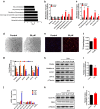Zoledronate dysregulates fatty acid metabolism in renal tubular epithelial cells to induce nephrotoxicity
- PMID: 28871336
- PMCID: PMC5773652
- DOI: 10.1007/s00204-017-2048-0
Zoledronate dysregulates fatty acid metabolism in renal tubular epithelial cells to induce nephrotoxicity
Abstract
Zoledronate is a bisphosphonate that is widely used in the treatment of metabolic bone diseases. However, zoledronate induces significant nephrotoxicity associated with acute tubular necrosis and renal fibrosis when administered intravenously. There is speculation that zoledronate-induced nephrotoxicity may result from its pharmacological activity as an inhibitor of the mevalonate pathway but the molecular mechanisms are not fully understood. In this report, human proximal tubular HK-2 cells and mouse models were combined to dissect the molecular pathways underlying nephropathy caused by zoledronate treatments. Metabolomic and proteomic assays revealed that multiple cellular processes were significantly disrupted, including the TGFβ pathway, fatty acid metabolism and small GTPase signaling in zoledronate-treated HK-2 cells (50 μM) as compared with those in controls. Zoledronate treatments in cells (50 μM) and mice (3 mg/kg) increased TGFβ/Smad3 pathway activation to induce fibrosis and kidney injury, and specifically elevated lipid accumulation and expression of fibrotic proteins. Conversely, fatty acid transport protein Slc27a2 deficiency or co-administration of PPARA agonist fenofibrate (20 mg/kg) prevented zoledronate-induced lipid accumulation and kidney fibrosis in mice, indicating that over-expression of fatty acid transporter SLC27A2 and defective fatty acid β-oxidation following zoledronate treatments were significant factors contributing to its nephrotoxicity. These pharmacological and genetic studies provide an important mechanistic insight into zoledronate-associated kidney toxicity that will aid in development of therapeutic prevention and treatment options for this nephropathy.
Keywords: Fatty acid transporter; Lipid accumulation; Renal fibrosis; TGFβ1 signaling; Zoledronate.
Conflict of interest statement
Conflict of interest
The authors declare that they have no conflict of interests.
Ethical standards
The manuscript does not contain clinical studies or participant data.
Figures







Similar articles
-
Characterization of urinary biomarkers and their relevant mechanisms of zoledronate-induced nephrotoxicity using rats and HK-2 cells.Hum Exp Toxicol. 2019 May;38(5):598-609. doi: 10.1177/0960327119829527. Epub 2019 Feb 11. Hum Exp Toxicol. 2019. PMID: 30744404
-
Loss of tumour suppressor PTEN expression in renal injury initiates SMAD3- and p53-dependent fibrotic responses.J Pathol. 2015 Aug;236(4):421-32. doi: 10.1002/path.4538. Epub 2015 Apr 27. J Pathol. 2015. PMID: 25810340 Free PMC article.
-
Involvement of FATP2-mediated tubular lipid metabolic reprogramming in renal fibrogenesis.Cell Death Dis. 2020 Nov 20;11(11):994. doi: 10.1038/s41419-020-03199-x. Cell Death Dis. 2020. PMID: 33219209 Free PMC article.
-
Targeting fatty acid metabolism for fibrotic disorders.Arch Pharm Res. 2021 Oct;44(9-10):839-856. doi: 10.1007/s12272-021-01352-4. Epub 2021 Oct 18. Arch Pharm Res. 2021. PMID: 34664210 Review.
-
Bisphosphonate nephropathy: A case series and review of the literature.Br J Clin Pharmacol. 2021 Sep;87(9):3485-3491. doi: 10.1111/bcp.14780. Epub 2021 Mar 4. Br J Clin Pharmacol. 2021. PMID: 33595131 Free PMC article. Review.
Cited by
-
Is the proximal tubule the focus of tubulointerstitial fibrosis?Heliyon. 2023 Feb 6;9(2):e13508. doi: 10.1016/j.heliyon.2023.e13508. eCollection 2023 Feb. Heliyon. 2023. PMID: 36846656 Free PMC article. Review.
-
Fatty acid transport protein-2 regulates glycemic control and diabetic kidney disease progression.JCI Insight. 2020 Aug 6;5(15):e136845. doi: 10.1172/jci.insight.136845. JCI Insight. 2020. PMID: 32614804 Free PMC article.
-
PI3K/AKT/mTOR Dysregulation and Reprogramming Metabolic Pathways in Renal Cancer: Crosstalk with the VHL/HIF Axis.Int J Mol Sci. 2023 May 7;24(9):8391. doi: 10.3390/ijms24098391. Int J Mol Sci. 2023. PMID: 37176098 Free PMC article. Review.
-
The Contribution of Lipotoxicity to Diabetic Kidney Disease.Cells. 2022 Oct 14;11(20):3236. doi: 10.3390/cells11203236. Cells. 2022. PMID: 36291104 Free PMC article. Review.
-
Kidney lipid dysmetabolism and lipid droplet accumulation in chronic kidney disease.Nat Rev Nephrol. 2023 Oct;19(10):629-645. doi: 10.1038/s41581-023-00741-w. Epub 2023 Jul 27. Nat Rev Nephrol. 2023. PMID: 37500941 Review.
References
-
- Bottinger EP, Bitzer M. TGF-β signaling in renal disease. J Am Soc Nephrol. 2002;13(10):2600–2610. doi: 10.1097/01.ASN.0000033611.79556.AE. - DOI - PubMed
MeSH terms
Substances
Grants and funding
LinkOut - more resources
Full Text Sources
Other Literature Sources
Medical

